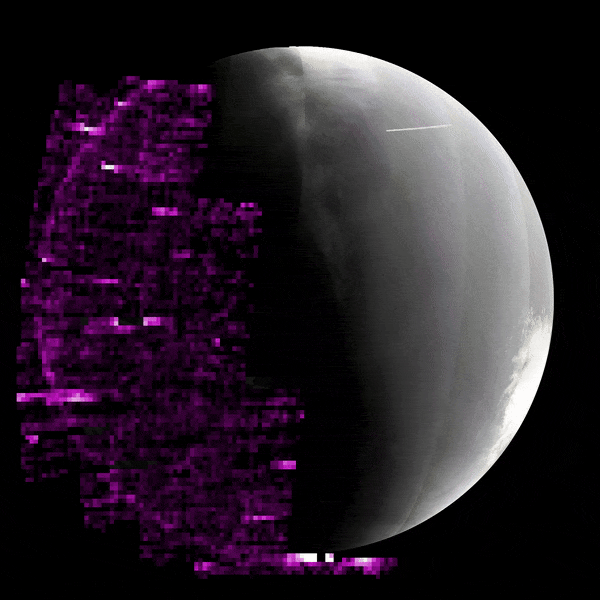Sun
See Ten Awe-Inspiring Images From the Astronomy Photographer of the Year Contest
Auroras, nebulas and stars take the spotlight in this space-themed competition, alongside shots of our own sun and moon
A 'Major Lunar Standstill' Is Happening This Year—and Friday's Full Moon Offers 'Dramatic' View
From now through much of next year, the moon will periodically rise and set at its most extreme points, thanks to a rare celestial phenomenon that only occurs every 18.6 years
Mars Was Hit With a Solar Storm Days After Earth's Aurora Light Show, NASA Says
Studying this event could hold lessons for scientists about how to protect astronauts from radiation on future trips to the Red Planet
A Giant Interstellar Cloud May Have Once Enveloped Earth, Potentially Causing Ice Ages
Astronomers suggest this cold, dense cloud compressed our sun's protective field between two and three million years ago, leaving the Earth exposed to cosmic material
Missed the Auroras in May? Here’s How to See Them Next Time
Three veteran aurora chasers and a NASA scientist share everything you need to know to check these dazzling displays off your bucket list
Researchers Trace the Origin of the Sun's Magnetic Field, Shedding Light on Space Weather and Solar Cycles
In a new study, scientists suggest the sun's magnetic field originates much closer to the star's surface than previously thought, a finding that could boost predictions of solar activity
See 12 Breathtaking Images of the Northern Lights, Spotted in Shocking Places Over the Weekend
A period of unusually strong solar activity meant the colorful aurora borealis could be seen much farther south than normal
Were Stonehenge's Builders Guided by the Moon?
Researchers are studying the monument's connection to a celestial event that occurs every 18.6 years
When Are the Next Solar Eclipses? 2026 Promises Totality in Europe, While Much of America Has a Decades-Long Wait
The next total solar eclipse visible from the contiguous U.S. won’t take place until August 23, 2044—but eclipse chasers will have other opportunities to experience totality before that
A Secretive Experiment Released Salt Crystals Over San Francisco Bay—Could It Help Curb Warming?
The technology could make clouds reflect more sunlight, cooling the Earth below. But even the scientists leading the study say letting go of fossil fuels is a much-preferred response to climate change
Watch the Total Solar Eclipse From Your Home With These Live Streams Online
Not in the path of totality? See the moon blot out the sun, revealing its magnificent corona, from your computer or phone
The Long History of Art Inspired by Solar Eclipses
For centuries, curious artists have been trying to make sense of the celestial event
Listen Live to the Total Solar Eclipse, Transformed Into a Real-Time Musical Composition
A composer based at San Francisco’s Exploratorium museum will use data coming from the eclipsed sun to create an out-of-this-world “sonification” on April 8
Why We Love Eclipses
Two perspectives on the astronomical phenomenon that has fascinated humans for as long as we’ve been watching the skies
This Handheld Device Allows Blind People to Experience the Solar Eclipse With Their Ears
The technology, which translates the intensity of sunlight into a range of sounds, was designed to make eclipses more accessible to visually impaired people
This Is the Gear You Need to View the 2024 Total Solar Eclipse
Protect your eyesight with eclipse glasses, binoculars, telescopes or lens filters
Five Fascinating Science Projects Using the Total Solar Eclipse to Illuminate New Discoveries
The NASA-supported experiments are mobilizing legions of researchers and volunteers to capture wide-ranging observations during totality, from amateur radio operations to elusive solar plumes to unusual animal behavior
Mars Has an Unexpected Influence on Earth's Oceans and Climate, Repeating Every 2.4 Million Years, Study Finds
The gravitational interactions between Mars and Earth as they orbit the sun may have periodically promoted a warmer climate and changes in ocean circulation on our home planet
A History of Total Solar Eclipses Seen by Astronauts From Outer Space
Since the Gemini 12 mission in 1966, a handful of people have seen these stunning celestial events from orbit—or watched the moon’s shadow pass over Earth
How Ancient Texts Can Shed Light on Auroras
Documenting episodes of the phenomenon thousands of years ago may help us predict damaging solar storms in the future
Page 1 of 10
:focal(1005x1082:1006x1083)/https://tf-cmsv2-smithsonianmag-media.s3.amazonaws.com/filer_public/14/0d/140d68d7-f50b-47b1-b957-c3482b9d2915/abandoned_house.jpg)
:focal(1920x1280:1921x1281)/https://tf-cmsv2-smithsonianmag-media.s3.amazonaws.com/filer_public/05/91/059191fc-b3c1-406b-89c0-27f492723ceb/pexels-peter-de-vink-288978-975012.jpg)

:focal(537x445:538x446)/https://tf-cmsv2-smithsonianmag-media.s3.amazonaws.com/filer_public/e8/b6/e8b68174-1c9b-465e-8469-b66151dd09fa/heliosphere.jpg)
:focal(360x240:361x241)/https://tf-cmsv2-smithsonianmag-media.s3.amazonaws.com/filer_public/47/ed/47ed2f31-f77b-4c3f-a20a-574bc1a8c214/sinha2_aurorasaurus_pho_20240411.jpg)
:focal(900x844:901x845)/https://tf-cmsv2-smithsonianmag-media.s3.amazonaws.com/filer_public/dc/70/dc707415-ed07-4cb0-a6d6-5445853e8046/gsfc_20171208_archive_e000393orig.jpg)
:focal(3842x2580:3843x2581)/https://tf-cmsv2-smithsonianmag-media.s3.amazonaws.com/filer_public/57/c0/57c0194a-54ac-4e05-b226-ed838e4a9bbd/gettyimages-2151911419.jpg)
:focal(1632x1228:1633x1229)/https://tf-cmsv2-smithsonianmag-media.s3.amazonaws.com/filer_public/2e/cb/2ecb6996-6343-4a73-a916-c10219dc64ce/the_moon_and_stonehenge_james_o_davies_english_heritage.jpeg)
:focal(1500x1007:1501x1008)/https://tf-cmsv2-smithsonianmag-media.s3.amazonaws.com/filer_public/d9/3f/d93ff800-73dc-47fa-97f3-ef0d1ecf5ece/gettyimages-2147666813.jpg)
:focal(1280x853:1281x854)/https://tf-cmsv2-smithsonianmag-media.s3.amazonaws.com/filer_public/58/46/58467362-e456-4aac-949f-8aeef382e29d/gettyimages-85783311.jpg)
:focal(3072x2048:3073x2049)/https://tf-cmsv2-smithsonianmag-media.s3.amazonaws.com/filer_public/f2/d0/f2d06687-f8a6-4950-b6c5-8fd5f42e036e/36336061393_f5361c15f0_6k.jpg)
:focal(1218x690:1219x691)/https://tf-cmsv2-smithsonianmag-media.s3.amazonaws.com/filer_public/6b/1c/6b1cfcc8-f8af-4174-bb06-ed982d24b719/viewfinder_still_1_cmyk_copy.jpg)
:focal(360x207:361x208)/https://tf-cmsv2-smithsonianmag-media.s3.amazonaws.com/filer_public/7a/f9/7af9a4bb-32a7-463e-a681-f86cddcdc135/eclipse_1-1280-1.webp)
:focal(700x527:701x528)/https://tf-cmsv2-smithsonianmag-media.s3.amazonaws.com/filer_public/c9/98/c9981180-9665-4e4e-8390-93dcf586d711/smithmag-podcast-s02-ep04-eclipse-article.jpg)
:focal(2071x1381:2072x1382)/https://tf-cmsv2-smithsonianmag-media.s3.amazonaws.com/filer_public/72/6a/726a1489-cdf7-4ecd-b7a4-fe06092feff0/gettyimages-1153328331.jpg)
:focal(2377x1607:2378x1608)/https://tf-cmsv2-smithsonianmag-media.s3.amazonaws.com/filer_public/6c/55/6c556cbf-d7c6-43ac-bd2f-b3f9d47605f6/gettyimages-836328338.jpg)
:focal(450x339:451x340)/https://tf-cmsv2-smithsonianmag-media.s3.amazonaws.com/filer_public/b4/37/b4370cf8-9d77-4795-a3fa-63c5549e5c5b/ezgif-7-192a70d806_cropped.jpg)
:focal(681x512:682x513)/https://tf-cmsv2-smithsonianmag-media.s3.amazonaws.com/filer_public/0a/d7/0ad73452-f6d2-47e4-ad5b-d4bc1abae738/ezgif-3-0b922f8a81_cropped.jpg)
:focal(2784x1856:2785x1857)/https://tf-cmsv2-smithsonianmag-media.s3.amazonaws.com/filer_public/00/ab/00ab5453-811b-405b-9a04-08564356478b/iss063-e-31763.jpeg)
:focal(800x602:801x603)/https://tf-cmsv2-smithsonianmag-media.s3.amazonaws.com/filer_public/72/ba/72ba90f4-730a-47b5-acd1-80a445b88a52/aurora_nagoya_1770_web.jpg)